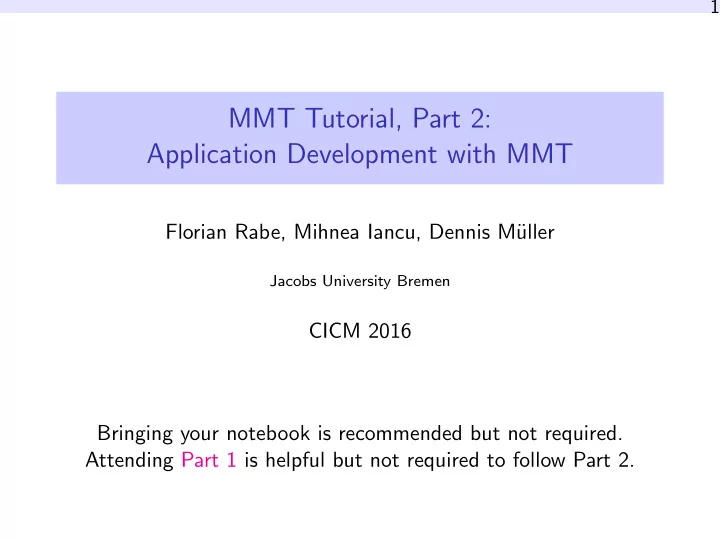

1 MMT Tutorial, Part 2: Application Development with MMT Florian Rabe, Mihnea Iancu, Dennis M¨ uller Jacobs University Bremen CICM 2016 Bringing your notebook is recommended but not required. Attending Part 1 is helpful but not required to follow Part 2.
Developing based on MMT 2 Users vs. Developers MMT blurs the distinction between users and developers ◮ MMT is not an application itself ◮ It is a ◮ API for the MMT language close relative of OMDoc ◮ suite of reusable algorithms/services e.g., MKM services ◮ set of few example applications e.g., the IDE used in Part 1 ◮ Primary users: developers of math applications ◮ Secondary users: users of those applications
Developing based on MMT 3 Basic Design of MMT Implementation ◮ Data structures for MMT language documents, modules, declarations, objects get, add, update, delete ◮ Core algorithms parse, check, simplify, present, . . . index, query, diff, build, . . . ◮ Backend ◮ catalog for mapping MMT URIs to physical locations in git repositories, databases, etc. ◮ transparent loading/unloading into memory ◮ Frontend ◮ API calls from Scala, Java programmatic or interactive ◮ shell, scripting language ◮ HTTP server core algorithms exposed
Developing based on MMT 4 Extension Interfaces MMT systematically exposes extension interfaces essentially everything can be extended or replaced ◮ Customize core algorithms ◮ add rules declared in MMT theories ◮ replace with custom implementations ◮ combine algorithms for structural and object level ◮ Adding language features ◮ literals with external data/computation ◮ pragmatic features with elaboration semantics ◮ Import/export interfaces for integrating other formats and build targets ◮ Outside interface ◮ adding new command line syntax ◮ web framework for adding new HTTP interfaces ◮ Change listening infrastructure for content events
Breadth of Possible Applications 5 Example: jEdit IDE Application: IDE for MMT theories ◮ based on jEdit text editor ◮ induces IDE for any ◮ language defined in MMT ◮ language exported to OMDoc Design: MMT as p MMT and jEdit ◮ Plugin for jEdit that wraps arond MMT ◮ MMT and jEdit large projects ◮ But only little glue code needed mostly forwarding to MMT API functions
Breadth of Possible Applications 6 Example: HOL Light library browser Based on ◮ definition of HOL Light in MMT/LF ◮ export of HOL Light library in OMDoc format MMT provides out of the box ◮ HTML+MathML rendering of library including 2-dimensional notations ◮ as interactive documents definition lookup, type inference ◮ dependency graph of theorems
Breadth of Possible Applications 7 Example: Generation of GAP Inheritance Graphs Based on GAP export to OMDoc Only a few lines of code to ◮ generate additional predicates for MMT’s relational index ◮ register a new graph built from this predicate yield ◮ generation of inheritance graph between GAP filters ◮ interactive, integrated with web browser
Breadth of Possible Applications 8 Example: Codec-Based Knowledge Exchange Problem: ◮ mathematical data distributed over multiple databases LMFDb, OEIS, findStat.org, . . . ◮ in incompatible, unspecified low level encodings Solution: Codec infrastructure of MMT ◮ MMT theory for codecs and codec operators ◮ Describe database schemas ◮ using mathematics-near types ◮ annotate codec expressions to define concrete encoding ◮ Treat databases as MMT backends Effect: MMT provides uniform high-level interface to low-level databases
Breadth of Possible Applications 9 Example: MathHub Application: ◮ Project hosting platform for mathematical library based on gitlab ◮ Web interface for browsing, interacting with libraries based on Drupal ◮ MMT used to process, interpret the content Implementation: suite of MathHub-specific MMT extensions ◮ new sTeX importer for interpreting sources uses MMT’s build syste ◮ HTML presenter for producing web pages uses MMT’s MathML presenter for objects ◮ HTTP server plugin for high-level MathHub specific queries uses MMT web framework, API functions ◮ HTTP server plugin for browser-based editing uses same functions as jEdit IDE
Structure of the Tutorial 10 Overview 1. Brief introduction to MMT-based Applications 2. 3 mini-demos of prototypical MMT-based applications easy for attendants to understand, reprocude, modify 2.1 Changing equality by adding arbitrary rewrite or computation rules 2.2 Using the MMT query interfaces to build a browser-based editor 2.3 Using MMT’s export infrastructure to build an OpenMath Content Dictionary editor
Structure of the Tutorial 11 Let’s Start ◮ I will show mini-demos on the screen ◮ The tutorial points to the self-documenting source files ◮ Some demos can be run/changed by you as well ◮ Main link: http: //uniformal.github.io/doc/tutorials/applications/ no need to type this — these slides are linked from the CICM program
Recommend
More recommend